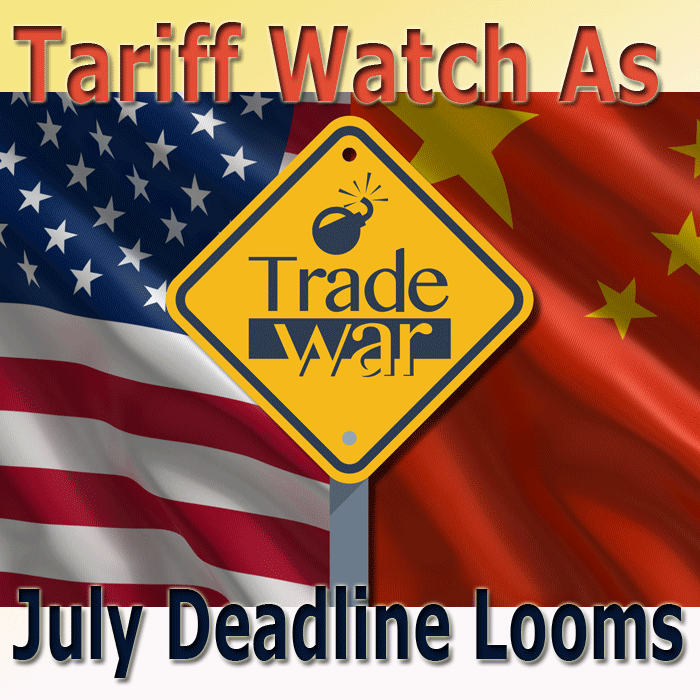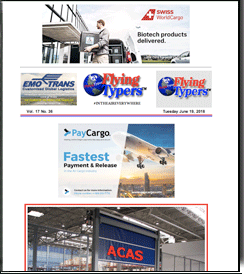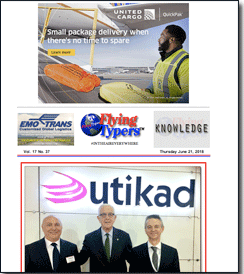
As
deadline day draws near in the on-off trade war
dance between the United States and China, forwarders
and airlines are now making strategic preparations
for potential spikes in demand.
They are also preparing
for the possibility that demand could drop off
thereafter on the China to U.S. lane, and that
Chinese production for the U.S. market could quickly
shift to Chinese factories located in neighboring
Asian countries to avoid tariffs.
The
Urge To Surge
United States President
Donald Trump said earlier this month that the
U.S. would slap 25 percent tariffs on US$50 billion
worth of Chinese goods, with the first wave covering
818 products worth US$34 billion taking effect
on July 6.
 Brandon
Fried, Executive Director of Washington-based
The Airforwarders Association, said a surge in
demand was likely ahead of the deadline. Brandon
Fried, Executive Director of Washington-based
The Airforwarders Association, said a surge in
demand was likely ahead of the deadline.
“There may
well be a spike in air cargo as the July 6th tariff
imposition deadline nears and importers bringing
goods into the U.S. from China hope to beat the
increased taxes on those goods,” he told FlyingTypers.
“While air
cargo provides faster service and hence more time
value, the mode tends to cost more so companies
will need to decide whether paying taxes or the
higher freight expenses works best.
“The same
may happen when the announced tariffs between
the U.S. and Europe take effect.
“Now is the
perfect time for forwarders to meet with their
customers to help provide creative options for
those seeking a better understanding of how the
looming tariffs may affect their upcoming shipments.”
Seeking
Alterative Routes
Heeding Fried, that
is exactly what service providers contacted by FlyingTypers are doing. Although
a number of Chinese airlines contacted by FlyingTypers refused to comment, a spokesperson for Japanese
carrier ANA said the airline was currently examining
what the tariffs might mean for freight demand,
with some expectation that cargo heading for the
U.S. will increasingly be produced and shipped
from regional alternatives in Asia to avoid the
tariffs.
“Should the
freight demand between China and the U.S. slow
down due to the U.S. tariffs on China, we will
be focusing on boosting the demand from Japan
and South/East Asia to the U.S.,” said the
spokesperson.
“We are watching
the market carefully.”
Last Minute Deal?
Asked if a surge
in demand was expected before the implementation
of tariffs, a spokesman for Taiwan-based carrier
China Airlines said there was still a lot of uncertainty
over the amount and type of tariffs that China
and the U.S. planned to impose, or whether negotiations
could result in a last-minute stay of execution.
“The demand
for hold space from Chinese exports to the U.S.
may however shift to other Asian countries due
to a transfer of production lines as well,”
he said.
“Our regional
and trans-Pacific capacity will be adjusted as
necessary to maintain the profitability of the
overall network.” (see article below).
The
Forwarder View
 Forwarders in Asia
are also taking steps to ensure they are prepared
ahead of the July 6 deadline. Speaking in the
fourth week of June, Li Wenjun, SVP and Head,
Air Freight, DHL Global Forwarding Asia Pacific,
said so far there had not been a surge in volume,
but an increased push ahead of the deadline was
a possibility. Forwarders in Asia
are also taking steps to ensure they are prepared
ahead of the July 6 deadline. Speaking in the
fourth week of June, Li Wenjun, SVP and Head,
Air Freight, DHL Global Forwarding Asia Pacific,
said so far there had not been a surge in volume,
but an increased push ahead of the deadline was
a possibility.
“What we have
seen since the beginning of the year is a continued
strong market to and from the United States, so
we created further capacities and accessibility
to our global logistics network with a second
Around-the-World flight, which we launched in
May,” he said. “This flight offers
our customers the best-possible solutions for
the strong market so far and any other increased
capacities that may result in the coming weeks.”
Other
Voices
  Sou
Ping Chee, (left) Regional Head of Air
Freight Asia Pacific at Panalpina, related a similar
tale, noting: “So far, we have not seen
any production or demand shift ex-China as a result
of the current tariff dispute between the U.S.
and China. Most shippers are likely still watching
the developments since the situation is dynamic
and uncertain.” Sou
Ping Chee, (left) Regional Head of Air
Freight Asia Pacific at Panalpina, related a similar
tale, noting: “So far, we have not seen
any production or demand shift ex-China as a result
of the current tariff dispute between the U.S.
and China. Most shippers are likely still watching
the developments since the situation is dynamic
and uncertain.”
iContainers Vice
President for Sales and Operations Klaus Lysdal (right) said any demand rush from China
to the U.S. by air freight would likely be similar
to a pre-holiday period spike. “The surge
in demand will probably be similar to the holiday
rush we get each year when you always see some
importers realizing last minute that this needs
to move now to get here before deadline,”
he said. “So I imagine we will see some
reaction with air freight and potentially some
last minute activity with ocean freight on the
west coast just to get here to clear customs in
time.”
SkyKing
  “The
situation is extremely complex,” says
TIACA Hall of Fame recipient and former
President of American Airlines Cargo Bill
Boesch, “and the carriers at the most
risk, in my opinion, will be the non-U.S.
commercial schedule freighter operations. “The
situation is extremely complex,” says
TIACA Hall of Fame recipient and former
President of American Airlines Cargo Bill
Boesch, “and the carriers at the most
risk, in my opinion, will be the non-U.S.
commercial schedule freighter operations.
“As we all know, the U.S.
does not really have any scheduled freighter
airlines other than Amerijet and the integrators,
who may benefit.”
DHL
Impact?
“The non-U.S. Integrators
like DHL may be negatively affected as they
have ACMI contracts with USA flag carriers
such as Atlas, National, and Kalitta, who
supply freighters with U.S. routing authority.
“These carriers also have
5th and 6th freedom rights, so the traffic
between Asia and Europe could pick up significantly
utilizing their freighters as the U.S. dollar
is still low, meaning that their rates would
be competitive in U.S. dollars.”
Pharma
Challenge
“The major problem here
is uncertainty, but the U.S. non-integrator
airlines that fly freighters under ACMI
contracts have protected themselves.
“I don't see much effect
for the U.S. integrators like UPS and FedEx
as U.S. internal traffic should increase
while the international traffic that they
carry will mostly be parts, which may not
be covered by these trade tariffs.
“Pharmaceuticals are a
major trade war risk for other countries,
as most of the global industry is controlled
by U.S. trade patents and that could have
a significant effect on various countries’
ability to secure these vital drugs.”
Labor
& U.S. Dollar
“In my view, the biggest
challenge for the U.S. airlines in the trade
war scenario would be an increase in the
value of the U.S. dollar. U.S. carriers
have had to bear higher labor costs during
the past 2 years.
“A high dollar would put
them at a disadvantage with the foreign
carriers.
“I think the U.S. Administration
is smart enough to realize that and will
continue to keep the dollar low.”
Iran
& Korea
“As I said, the complexity
of this is almost overwhelming as it has
multiple factors.
“Another concern is if
North Korea and Iran heats up, that might
change the entire picture.”
|
|




 Vol.
17 No. 36
Vol.
17 No. 36 Vol.
17 No. 37
Vol.
17 No. 37